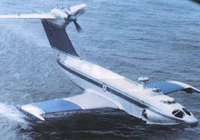Russian government hides Caspian Monsters. Why?
Ever since 1964, when the world’s first wing-in-ground effect (WIGE) craft was tested by Russia in the Caspian Sea, Russia keeps the leading positions in the development of a special class of vehicles dubbed “Caspian Monsters” by the US intelligence, which are neither aircraft nor ships, or both. Caspian Monsters used to create a furore in news making and technical spheres. Today the world catches a single piece of news regarding the fate of this outstanding development. As a well-informed source in the Russian military-industrial complex said to the correspondent of Pravda.Ru screen planes were considered by Russian Maritime Collegium at the meeting held in Nizhni Novgorod. Noteworthy, although the topic was discussed on the level of the First Vice-Premier Sergey Ivanov, who even mentioned a federal target program under which WIGE could be created, there have been no noticeable follow-up developments, if any.

Today the rank and file readers think that Russian government still does not pay attention to this technology which has obvious and recognized advantages. It may be said that screen planes are not financed in principle. Certain adjacent developments are financed to a limited degree. Some companies and designers are trying to promote small versions of WIGE (called in Russian screen planes). Pravda.Ru already wrote about Kalganov’s Ivolga and Aquaglide of the Arctic Trade and Transport Company. However, according to the source of Pravda.Ru it is out of the question for any individual company to develop the screen planes of the size of the Caspian Monster with just own money. No single company can afford it. State financing is absolutely necessary.
In spite of the fact that according to the media sources several nations are quickly advancing in the sphere of WIGE (USA, China, Germany) Russian government rejects all proposals on cooperation in this sphere. Some Russian companies get proposals from foreign customers on developing the screen planes of under 50 tons class, but cannot take these contracts because the state does not allow that. As of today there is no export permission for the screen planes as for the dual technology. It is true that there are enough specialists in the military-industrial complex of Russia who nearly publicly state that the permission system of the state is not correct. According to them without export Russian companies may lose screen planes at all. However, the government neither does anything in Russia, nor allows international cooperation.
Russian designers of the screen planes continue to work on the subject at own initiative, but the pace of work is noticeably smaller than that of their foreign competitors. The latter are quickly advancing in some WIGE related technologies. In some areas, like equipment, they are even ahead. There are enough businessmen in Russia who believes that the nation should use the prospects in the sphere of the screen planes it has abroad. Because these prospects cannot be realized without the respective export policy of the state they intend to lobby the idea in different governmental structures. We are sure to hear more about this matter in the foreseeable future. It seems that both the public and the business want the state to clarify its position.
It is high time to do that. Today one Russian radio-electronic holding is developing a comprehensive electronic complex for Alexeeva’s screen plane Spasatel (rescuer). This complex is deemed for the absolutely new screen plane. This is an “old new” model. From the point of view of the properties of the vehicle in gas and water environments there are no questions left. Physics were fixed by Rostislav Alexeev, the designer of the Caspian Monsters. The screen plane looks as it used to. However, new materials, equipment, design composition and engines make the craft totally different. This work is done by one of the former traditional partners of the KB Alexeeva.
Noteworthy, today’s developments of the screen planes take place in the civil sphere. However, their possible military application remains very impressive. Before the disintegration of the USSR the Soviet Navy planned commissioning about 120 screen planes, mainly in the Black- and the Baltic Sea Navies. Let’s remind that the first Caspian Monster (KM) had a lifting power of 1,000 tonnes. First tested in 1964 it keeps the world’s record of take off weight (544 tons) among the flying devices invented by the mankind. KM was able to take off with that weight in the conditions of three grades storm. It was over 100 m long, fully loaded weighed 540 tonnes and had the speed of over 400 km/h being just couple of meters above the surface of the water thus remaining invisible for the radars.
The second one was medium-sized A-90 "Orlyonok" (140 tonne, 58 metre long, maiden flight in 1972). It was purely rescue model. (Which is now being perfected). Five were built, two lost in tests. Other entered military service in 1979.
However, the most impressive and perfect was the third model Lun, designed as a sea-launched anti-ship missile platform. Its multiple missile launch was comparable to that of a destroyer, whereas the screen plane was times cheaper and times faster. Lun (M-160) armed with Moskit anti-ship cruise missiles was 280 tonne, 74 metre long. Nicknamed “the killer of aircraft carriers” it was capable of flying and firing in the conditions of 6-7 grades storm. One was built in 1987 and entered service in 1989. The second was under construction when the Soviet Union disintegrated.
The point that the screen planes remain very attractive for the militaries is clear. In 2002 Boeing announced that it was developing the mother of all screen planes: the monstrous "Pelican" which would stretch more than the length of a US football field and have a wingspan of 500 feet. The Pentagon wanted this particular bird to carry 17 M-1 main battle tanks on a single sortie. However, it must have remained only in their dreams, whether we'll ever be able to look at a Pelican remains to be seen.
Yuri Seleznev
Pravda.ru
Subscribe to Pravda.Ru Telegram channel, Facebook, RSS!





